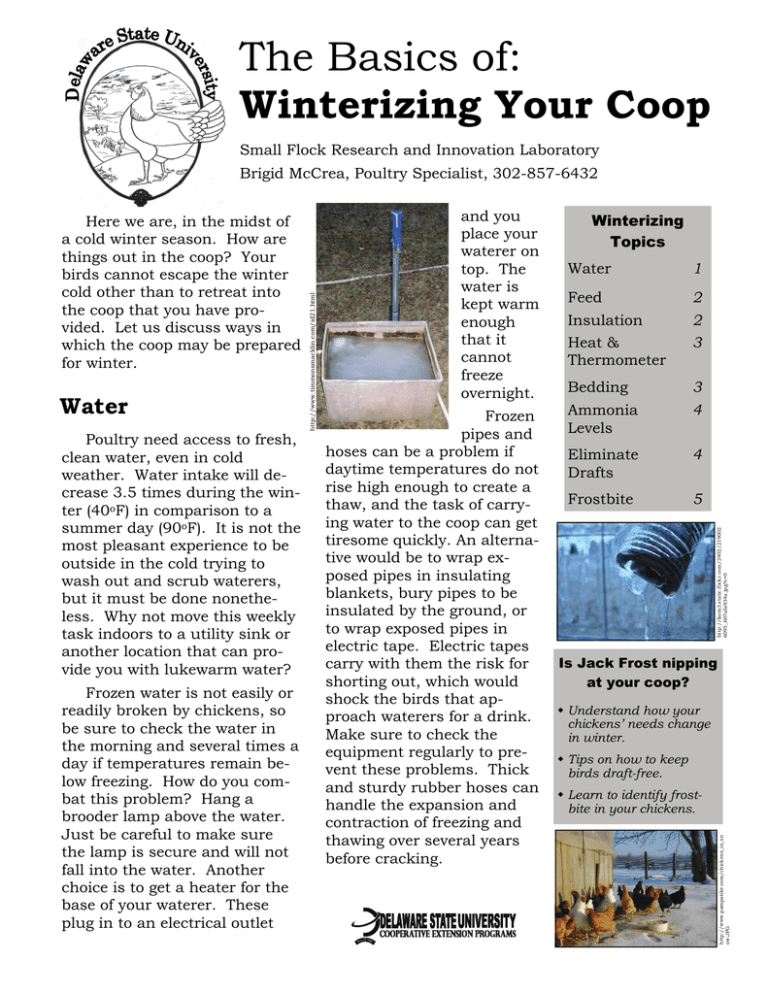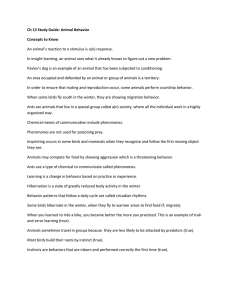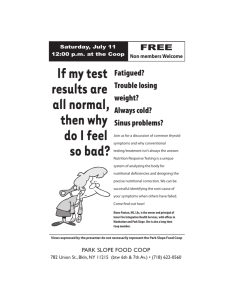The Basics of - Delaware State University
advertisement

The Basics of: Winterizing Your Coop Small Flock Research and Innovation Laboratory Poultry need access to fresh, clean water, even in cold weather. Water intake will decrease 3.5 times during the winter (40oF) in comparison to a summer day (90oF). It is not the most pleasant experience to be outside in the cold trying to wash out and scrub waterers, but it must be done nonetheless. Why not move this weekly task indoors to a utility sink or another location that can provide you with lukewarm water? Frozen water is not easily or readily broken by chickens, so be sure to check the water in the morning and several times a day if temperatures remain below freezing. How do you combat this problem? Hang a brooder lamp above the water. Just be careful to make sure the lamp is secure and will not fall into the water. Another choice is to get a heater for the base of your waterer. These plug in to an electrical outlet Frozen pipes and hoses can be a problem if daytime temperatures do not rise high enough to create a thaw, and the task of carrying water to the coop can get tiresome quickly. An alternative would be to wrap exposed pipes in insulating blankets, bury pipes to be insulated by the ground, or to wrap exposed pipes in electric tape. Electric tapes carry with them the risk for shorting out, which would shock the birds that approach waterers for a drink. Make sure to check the equipment regularly to prevent these problems. Thick and sturdy rubber hoses can handle the expansion and contraction of freezing and thawing over several years before cracking. Winterizing Topics Water 1 Feed Insulation Heat & Thermometer 2 2 3 Bedding 3 Ammonia Levels 4 Eliminate Drafts 4 Frostbite 5 http://farm3.static.flickr.com/2402/219002 6095_607afa934a.jpg?v=0 Water and you place your waterer on top. The water is kept warm enough that it cannot freeze overnight. Is Jack Frost nipping at your coop? Understand how your chickens’ needs change in winter. Tips on how to keep birds draft-free. Learn to identify frostbite in your chickens. http://www.pampatike.com/chickens_in_sn ow.JPG Here we are, in the midst of a cold winter season. How are things out in the coop? Your birds cannot escape the winter cold other than to retreat into the coop that you have provided. Let us discuss ways in which the coop may be prepared for winter. http://www.timmonsmacklin.com/id21.html Brigid McCrea, Poultry Specialist, 302-857-6432 Feed If you are very observant of your flock, you will notice that feed intake will increase as the mercury drops. Laying hens will increase their feed consumption 1.5 times in winter months (40oF). This is a significant increase compared to summer days (90oF). Be sure to accommodate this additional need for energy by making sure that feeders are always full. There is no need to change the diet as birds will simply change their feed and water intake to accommodate for the cold weather. An acceptable addition for the coldest portions of winter would be to provide a couple handfuls of scratch grains to a pen of 10-20 birds each evening. This will allow birds a little extra energy to fuel the body through the cold nights. Scratch grains alone are an inadequate feed source, but are indeed a suitable supplement to the diet in the winter. Insulation This is often a forgotten portion of coop building, but it is definitely worth educating small flock owners on this topic. It is much easier to buy and apply sheets or boards of insulation, rather than to attempt to use large, fluffy rolls of insulation or a messy insulating foam. Sheets of insulation cost about $15-20 each, are available at most home improvement or hardware stores, and are easy to cut and apply. But you may be asking yourself, “Why bother? My great grandparents or grandparents did not insulate their coop’s walls and ceilings.” Well, here are the facts. We know a great deal more today about poultry than at the time of your Page 2 “Cold stress will lead to a drop in egg production for laying hens and poor weight gain in broilers.” great grandparents. The birds are not the same, the feed is very different, and the research has been done to determine the optimal conditions for housing poultry. Cold stress will lead to a drop in egg production for laying hens and poor weight gain in broilers. A good rule of thumb is that 55-75oF is a comfortable temperature for a chicken (layer or broiler). Would you rather spend more money in electricity trying to move cold air out or let your walls do all the work for you? Although Delaware State University it may seem counterintuitive, insulation will also benefit the flock in the summer by keeping coop temperatures lower and preventing heat from radiating into the coop. Insulation is a good investment for any small flock owner and, with the sale of a few dozen eggs or better feed conversion, can pay for insulation in a couple of weeks with better productivity. A hoop house in winter. The Basics of: Heat & Thermometer http://i7.photobucket.com/albums/y286/helena_the_chicken_lady/ All%20About%20Chickens/stablecoopconvert.jpg http://www.strombergschickens.com/images/brooders/UA2_L.jpg Unless you and make sure all is easily shrug off. Knowing purchased or rethe temperature will also in good working orceived older birds, help you decide whether or der. Although an almost every flock not additional lamps are average sized owner has chicken can produce needed to make birds combrooded chicks. the same amount of fortable. Use your brood heat as a 60 watt lamps to provide bulb, you may still “Use Min/Max supplementary need to add lamps. heat in the house thermometers so you know I recommend placduring the winter. exactly how much cold or ing 2 Min/Max therThis style of heat lamp They are safe to mometers in the is the same used to heat your birds are use if properly brood chicks. coop so that you will experiencing.” hung from the know how cold (or rafters or from a hot) it was during the night. hook in the coop. Rodents The first should be locan quickly chew through cated near the floor at string, so it is recommended bird height. The secthat wire or chain be used ond should be at perch for hanging lamps to lower height. It is easy to asthe risk of a fire from lamps sume that the birds that fall to the house floor. can take care of themIf extreme cold weather is selves, but how much forecasted, be sure to get ex- cold stress can one tra brood lamps. Consider bird take? Cold stress that local feed or poultry opens the door for dis- This coop provides supplemental heat by using a heat lamp. Extra bedding is supply stores may experieases that birds would placed on the floor. Extra straw is also ence a run on such items so otherwise be able to used in the nest boxes since they connect check your equipment early to an outside wall. Bedding Winterizing Your Coop This does not mean that regular cleaning should be delayed, but that will be discussed in the next point. http://www.osage.net/~themillers92/ SCFBlog/2006/11/cleaning-coop.html During the winter, it is only going to benefit your flock to add more bedding. Bedding will create an extra layer of insulation to the floor of the coop, thereby decreasing the amount of electricity (lower wattage bulbs) needed in the coop to provide warmth. This family cleans their coop regardless of the cold weather. Delaware State University Page 3 Ammonia Levels http://tinyfarmblog.com/chickens-just-wanna-eat/ It is often the thus causinclination of ing blindsmall flock keepness. ers to avoid Blind birds cleaning the cannot find coop regularly food or waduring the winter ter and months due to therefore the cold outside. lose weight. Broilers, meat chickens, huddling It is recomAdditionally, beneath brooder lamps in winter. mended that an birds that extra layer of bedding be are blind and losing weight added, but remember to can be considered an open maintain a regular cleaning sore in your flock because regimen. Ammonia is prothey are very susceptible to duced from the fecal matedisease. Additional burns rial of poultry. Ammonia is may occur on the bottoms of also released from decomthe feet and toes, as well as posing litter mixed with feon the breast of birds that ces. Levels that get too high prefer to lie in the litter. can physically burn and How do you know if the scar the cornea of the eye, ammonia levels are too high in your flock? Put yourself at bird level. That means you should put your face down at bird height. If you cannot keep your face down at that height for 3 minutes without your eyes watering or burning, then you should clean the coop more often. It is not enough to stand 5 feet tall and think that you are experiencing the same environment as the birds. If at the height of 5 ft, or higher if you are taller, you detect the strong smell of ammonia, then, without at doubt, it is time to change the litter. Eliminate Drafts Drafty coops can defy your every effort to keep temperatures high enough to keep birds happy and in lay. During the day, walk around the inside of your coop and look for cracks that let in light. Do not forget those mouse holes. A mouse can squeeze through any hole ¼ of an inch or larger. They will certainly enlarge any holes by chewing, thereby letting in more of a draft. Any hole or crack large enough to let in light is Page 4 “Use thick plastic or a tarp to eliminate drafts through cracks or holes in the wall.” certainly letting out heat. Save your pennies and seal up those cracks! You may find that your coop design may allow a draft and that you will need to winterize almost all of the 4 sides. The simplest method is to cover the crack Delaware State University or wall with thick plastic (apply with a staple gun to wooden surfaces). Thick plastic sheeting (like a high density painters plastic) or a tarp are both affordable solutions and available at most hardware stores. Once the long winter is over, the plastic is pulled down, staples are removed, and all is discarded. Note: Pick up all staples that have been removed. Chickens may eat any that you have missed. The Basics of: Frostbite Check your birds daily for signs of frostbite. Before giving frostbite an opportunity to stress and damage your birds, apply a thick layer of Vaseline to the entire surface of combs and wattles. How do you know if your birds have frostbite? You will see black spots on Winterizing Your Coop wattles affected by frostbite. You may choose to temporarily house your frostbitten birds in a warmer location where you can provide supplemental heat as they attempt to repair their bodies. Top: The black patches on the comb and wattles indicate frostbite. Bottom: The yellow coloration and blistering on the comb also indicates frostbite. Photo Courtesy Dr. Brigid McCrea Do not forget about toes! Your roosts should allow birds to pull their toes up against their bodies. Unusually shaped roosts prevent birds from surrounding all of their toes with the breast feathers. This may be of greatest concern with close-feathered breeds or with birds that are undergoing a winter molt. the comb or wattles that indicate where the cells are dying. Additionally, you may see yellowish blisters on affected areas. Some breeders choose to apply a thin layer of topical antibiotic under the Vaseline on the parts of the comb and http://www.thecozynest.com/picture%20page/frostbite2.jpg Frostbite is a serious concern for birds that have large combs and wattles. This is especially true of the males in some breeds. Birds with large combs may not be able to fit their entire comb underneath their wing during roosting. Do not forget the bills and caruncles of some ducks (Muscovy), as they can also suffer from frostbite. Be aware that birds with especially large and pendulous wattles may dip their wattles into the water while drinking, thereby increasing their risk of frostbite in the overnight hours. Delaware State University Page 5 Dr. Brigid McCrea Cooperative Extension Delaware State University 1200 N. DuPont Hwy. Dover, DE 19901 9003116 Summary Keeping your flock happy and healthy throughout the winter is key to warding off disease. A flock that is subjected to stress will begin to exhibit symptoms of colds or other ailments that may have been successfully hidden during other times of year. Remember, poultry can be asymptomatic carriers of disease until such time that they can not longer maintain their health. http://farm4.static.flickr.com/3161/2397181450_ec6a82b3d5.jpg?v=0 Cooperative Extension Education in Agriculture, Youth Development and Home Economics. Delaware State University, University of Delaware and the United States Department of Agriculture cooperating, Dr. Dyremple Marsh, Dean and Administrator. Distributed in furtherance of the Food and Agricultural Act of 1977. It is the policy of the Delaware Cooperative Extension System that no person shall be subjected to discrimination on the grounds of race, color, sex, disability, age or national origin. Delaware State University


